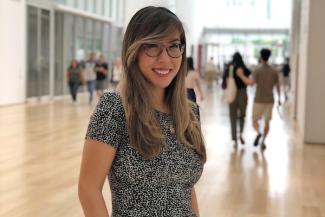
Susan Ahlborn, Omnia
In the U.S., the number of new marriages between two people of different racial or ethnic backgrounds has been growing, but same-race unions are still the norm. A report by the Pew Research Center in 2017—50 years after Loving v. Virginia legalized interracial marriage nationally—put the percentage at 17.
As a fifth-year doctoral candidate in sociology, Hu is working to understand the lives behind such statistics, to learn more about love and race, especially where the two intersect. “I’ve decided to study the social forces that shaped the creation of that viral list,” she says, “as well as love and desire more broadly.”
Hu’s main research method has been in-depth interviews, averaging two hours, with New York-based individuals who identify as East Asian women and who are in relationships with partners who identify as male and as white, Black, South Asian, or Southeast Asian. “Most of the sociological literature on interracial relationships focuses on couples in which one partner is white,” says Hu. “But this doesn’t allow us to understand how people of color navigate the racial boundaries that separate them from other people of color.”
Hu’s interviews cover the participants’ life histories, including where they grew up, who they hung out with, career paths, “those sorts of things,” she says. They then discuss how the participants’ relationships have been received by family members, friends, colleagues, even strangers the couple encounters. And finally, they talk about how participants themselves experience the relationships, “conversations or conflicts, perhaps, that revolve around racial, ethnic, or cultural differences,” says Hu.
The experiences really run the gamut, she adds. “There are some folks who are very aligned with their partners on racial issues and experiences, and then others who have very contentious conversations about race.”
Hu then codes and analyzes themes across the interviews. She conducted 47 for her master’s thesis. “For my dissertation my target is 100, so it’s a lot of talking, and I say I have no idea how I would do this work if I weren’t so extroverted,” she jokes.
One of her most interesting findings so far, outlined in a paper under review in an academic sociology journal, stresses the importance of early childhood platonic friendships in the development of individuals’ romantic preferences.
“My participants with white partners more frequently mentioned white friends when talking about how they developed their racial self-concepts and preferences,” Hu says. “In contrast, my participants with partners of color would often discuss non-white friend groups within which they could process what it means to be a racial minority and their experiences with racism, and develop pride in their racial identities. So basically, my participants with partners of color felt like their non-white friend circles provided a buffer against white racism and also encouraged them to think of whiteness as a sort of barrier to shared understanding in romantic contexts.”
Read more here.